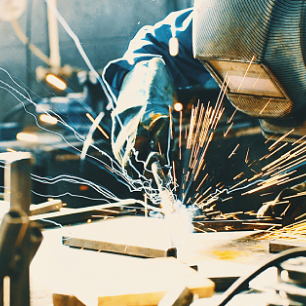Jump to:
Robot Spot Welding Guns as a Universal Tool
Robot spot welding plays a crucial role in industrial production, particularly in metalworking and the automotive sectors. These systems are integral to plants where heavy-duty, repetitive tasks require consistent and traceable outcomes. Over the years, robot spot welding guns have evolved from pneumatic-driven to servo-electric systems, paralleling advancements in industrial robotics. As robots have become more sophisticated, so too have their tools, with servo guns now representing the pinnacle of precision in spot welding, thanks to their ability to tightly control the welding process. Leading manufacturers today showcase a variety of servo guns as their flagship offerings, emphasizing their importance in modern manufacturing.
Key Features of a Robot Spot Welding Gun
In today’s competitive industrial landscape, where technological options abound, flexibility is increasingly seen as a key differentiator in spot welding systems.
Selecting the right robot and welding gun is often a complex challenge, complicated by the lack of flexibility in many current spot welding systems. What should someone looking for a robot welding gun focus on? Let’s explore the key aspects to consider.
1. Gun Body
The body of a robot spot welding gun serves as the structural backbone, holding the actuator, transformer, robot coupling, and arms together. Ensuring rigidity is crucial to maintain control over the welding process, as force needs to be transmitted consistently from the actuator to the welding caps. Additionally, a lightweight design is key to improving robotic efficiency. For instance, a lighter gun enables the choice of a lighter, faster robot, enhancing the overall productivity of the system and reducing floor space. Guns under 176 lb are typically considered a good lightweight, and some manufacturers have gone further, reducing weight to under 143 lb on the new lightweight models, without compromising on strength.
2. Inline Actuator
Actuators generate the necessary force for spot welding, and electric actuators are crucial in the case of servo guns. Inline actuators, which are better performing and lightweight, represent a modern approach to gun design. The choice of actuator — whether motorized or motorless, using a robot’s seventh-axis motor — impacts performance.
Some manufacturers produce their own actuators, while others use third-party options. Higher-standard actuators use an inverted roller screw system or eight-ball screw system, which guarantees the highest precision, near-zero-error movement, and minimal force variation even in challenging positions.
Key to ensure the maximum flexibility, as in TECNA’s (https://www.tecna.net/en/) new-generation guns, is the possibility to choose the actuator or to change it seamlessly, switching from own-made to third-party made in minutes. The company, based in Bologna, Italy, has over five decades of experience in spot welding technology.
3. Transformer
The transformer powers the welding process, providing the current necessary for welding in combination with the actuator’s squeeze force. The key features to look for in a transformer include power output, maximum welding current, heat capacity, cooling water requirements, and weight. A well-optimized transformer enhances gun performance while reducing operational costs through efficient water use and improved robot movement. For example, the company’s new generation of lightweight welding transformers requires 4 L/min (a little more than 1 gal/min) of water flow, improving efficiency. Some gun makers also offer compatibility with third-party transformers, delivering flexibility in welding projects.
4. Robot Coupling
The coupling connects the robot and the welding gun, and its design influences how the gun is mounted and operates. Mounting options range from rear to top, bottom, or side (either side), depending on the project’s specific requirements. Multiangle adjustable couplings, offered by a few manufacturers, increase the gun's versatility, allowing for greater flexibility in integrating it into robotic systems without replacing the coupling flange.
5. Arms Configuration
The welding gun's arms deliver current to the caps and can be made from full copper or partially aluminum for reduced weight. They can be standard or customized to reach challenging welding spots. The arms must provide rigidity to minimize force loss from the actuator, ensure low electrical resistance to minimize current loss from the transformer, and be lightweight to enable faster robot movement. Proper arm configuration directly influences the gun’s overall performance and efficiency.
Conclusion: The Need for a Universal Tool
When starting a new spot welding project, the five factors outlined in this article must be considered, as the choice of welding gun will significantly impact the project's success. In a rapidly evolving world, a robot welding gun should be a universal tool, not a limitation.
This article was written by Filippo Cortiglioni (area sales manager with TECNA and TECNA USA, Bologna, Italy) for the American Welding Society.


